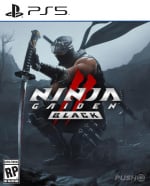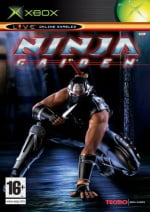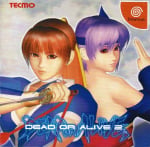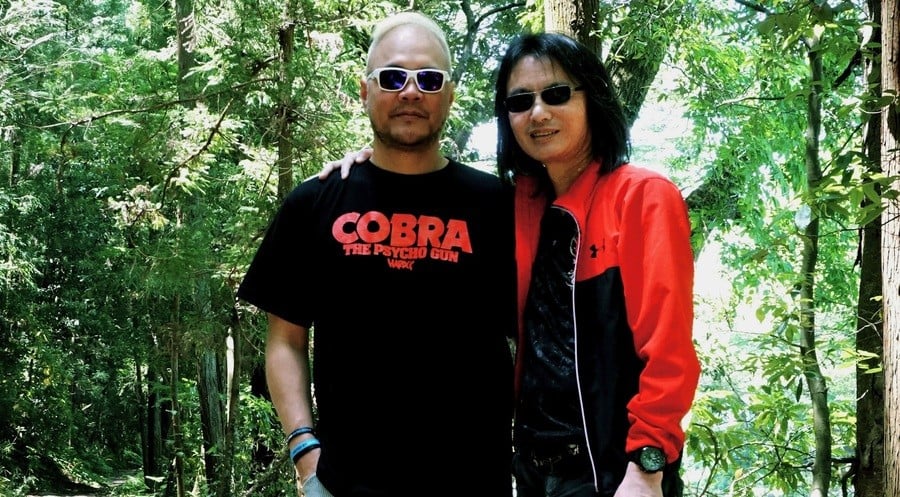
Years ago, after knowing each other for over 20 years, Tomonobu Itagaki —of his own accord— updated his Facebook profile and adjusted his relationship to me to be an “older brother.” He meant it in that Vin “I don’t have friends, I have family” Diesel way, minus the ham-fisted corniness. But it meant something. Itagaki-san was my family.
It’s still a bit raw for me to write this, and as a result, this whole long word dump is going to be an inelegant mess, but I think it’s better to get this on "paper" while the wounds are still fresh, so I don’t lose sight of recent events as the numbness scabs over my memories. If my name is at all familiar to you because of anything I’ve done in the past 27 years in gaming, just know that I have lost someone closer to me than your average ‘best friend’. I lost someone who was like a brother. And having grown up without any siblings, to call someone my brother is my highest expression of affection possible.
In the 1990s, I was a rabid importer of Japanese Sega Saturn games and reader of Sega Saturn Weekly. Which explains why, in 1997, when the unknown fighting game Dead or Alive hit the pages of Sega Saturn Weekly and then landed in New York City’s import shops, I snapped it up immediately, bringing it home and immediately enjoying the beautiful graphics, smooth 60fps gameplay, the reversal-style “hold” moves, impressive —uh— physics, and explosive danger zones. It was Virtua Fighter with less finesse and a lot more brutality, making Dead or Alive better suited to take Tekken head-on than Sega’s fighter was.

A few years later, working in the video game industry, I eventually had a chance to meet its creator, Itagaki-san, at E3 2002. I remember because he signed the back of my copy of Dead or Alive on the back of the booklet then.
I don’t remember much about that event —it’s been over 20 years and everything was larger-than-life then— but I vaguely recall having a nice conversation about the Dead or Alive series, including Dead or Alive 2 on Dreamcast and Dead or Alive 3 on Xbox, both of which were out by the time I met him. While I don’t remember the exact setting, I do remember asking him about the impact and influence of SEGA AM2 on his game and really getting honest about the series. Dead or Alive, it should be remembered, saved Tecmo’s ass from bankruptcy, being a success in both arcade and home conversions.
While I was working for Electronic Gaming Monthly at the time of our first meeting, I would soon move over to GMR magazine, where we put Dead or Alive Xtreme Beach Volleyball on the magazine’s first cover. For this cover feature, I traveled to Tecmo's then-headquarters in Ichigaya, Tokyo (where Koei Tecmo still resides, partly) and spent substantial time with the man famous for his long black hair, leather jackets, and dark sunglasses. For whatever reason, his persona did not intimidate me. We were both close in age (he was three years older than me), and he responded well to people who were straight-shooters. Being from New York City, I’m more or less precisely that.
Although his public persona was that of a heavy metal hardass, he was actually a very kind person. Yes, he did love to speak in metaphors a lot —usually ones involving World War II generals or the Bushido code of conduct— sometimes to the point of fatigue (me, being the fatigued one). But I learned that if you didn’t suck up to him or bullshit him, you’d quickly earn his trust. And if you earned his trust, then you were part of his inner circle. Because of this, we quickly got on good terms; though, unlike a lot of developers with whom I have good, longstanding relationships, Itagaki became an actual friend. We were always happy to see each other, and he has been a friend who has visited my home, been as much a friend to my wife and kids, and even helped me with my game Jupiter & Mars several years back.
But in these early days, visiting Tecmo in Tokyo, what he got from me was the honest, straight shooting, blunt feedback he had been asking for.
This is because Dead or Alive Xtreme Beach Volleyball was pretty broken. During my time with the game —a few days, but months before the first issue of GMR was ready to hit stands— I gave him a lot of valuable feedback as to what could be fixed. So much of the game still needed work: the camera angles were off, the game didn’t feel like a game so much as a tech demo or mini-game, and the game loop wasn’t really there.
As novel as this spin-off concept was at the time, I didn’t really find it compelling to play a busted volleyball game with no meaningful progression just to dress the DOA cast up in skimpy outfits and accessories. He calmly observed my play sessions, while taking notes, chain-smoking the entire time, and consuming many cans of Coffee Boss black coffee (bitter stuff) as I chipped away at the game. At the end of the sessions, he even liked my suggestion for the name of the shop on Zack Island, which was Zack of All Trades.
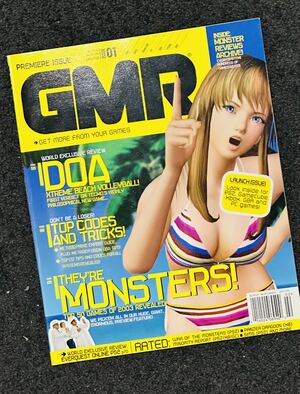
I truly believe the feedback I gave during the play sessions at Team Ninja helped transform it into something I felt was quite delightful and, unlike anything else at the time, and the experience opened up another opportunity for me. Whatever Itagaki saw in me during my time with their volleyball spin-off, he again wanted my insights on what would be, in my opinion, Team Ninja’s defining moment.
Ninja Gaiden was the closest thing to a masterstroke for Team Ninja, to revive an 8-bit platforming action game as a fully-realized Xbox-exclusive action game that put the entire industry on notice: There was a new dawg in town. As a result, months after our Dead or Alive Xtreme Beach Volleyball debut issue, I found myself back in Tokyo for a week-long hands-on with the early version of Ninja Gaiden. Result: More honest feedback. Possibly more than Itagaki was expecting.
There I was sitting on a leather couch in Team Ninja’s demo room, doing everything I could to not throw my controller through their widescreen TV. Back at the GMR offices, I had a reputation for yelling at any game with cheap AI, such as Def Jam Vendetta, and the Team Ninja offices were not spared this behavior. You had to have been there, though. Ninja Gaiden, as great as it turned out (especially with Ninja Gaiden Black), was ridiculously difficult in its early days. If you think the retail product was bad, that was nothing compared to the alpha.
That whole escapade on the zeppelin, where ninjas pop up out of the woodwork and train their machine guns on you — in the alpha, they had flawless aim and an eternal supply of ammo. I implored Itagaki-san to put some reloading animations in to give the player a break, and asked that their aim be tuned down to something more or less human. As it was, when I played, the instant I exposed Ryu Hayabusa, the ninjas automatically had me pinned down in a never-ending stream of 100% accurate gunfire. I asked him what the point of giving Ryu Hayabusa a fighting game’s depth and move lists was if the only thing that was even remotely feasible was the weakest, quickest attack?
Every day, he’d wheel out a new build and let me have a go, not in the least bit bothered by the large, noisy American in their smoky office threatening to level their TV at any given moment. I think he found it refreshing. Instead, he just laughed his head off, smoked a cigarette, drank a Coffee Boss, and took notes.
The ironic thing is that he wasn’t singing along to Metallica or anything. He was singing enka, the 19th-century Japanese music genre of melancholy ballads. Itagaki-san was nothing if not the realest Japanese dude I ever knew, who just gave zero f***s. Every day and every night I ever knew him, he put it all out there for you to appreciate or not.
One puzzle really annoyed me. I don’t recall the specific level, but it involved a key, which was submerged underwater, at the dead end of the aquatic labyrinth. “Who, in this game world, put this f***ing key here?” I demanded. Itagaki took note of this, laughed, and said my observation made a lot of sense, and wrote it down on his notepad. I don’t remember if they changed this in the final game — it might have been too late to adjust — but at least he acknowledged it.
During this trip, Itagaki-san took me out to dinner with his then-wife and daughter, at a restaurant specializing in pork, fairly close to his home in Tokyo. It was really then that I knew that our mutual trust was on another level.
Over time, he would take me out after our play sessions to get dinner at a local gyoza joint or to go out drinking. I’m not sure when exactly this happened, and whether it was for Ninja Gaiden 2 or Dead or Alive Ultimate or Dead or Alive Xtreme Beach Volleyball 2 or Dead or Alive 4, but one night he brought me out for a night of balls to the wall high-volume karaoke, in which he —after a half dozen whiskeys— screamed into the mic, threatening to rupture the karaoke bar’s sound system. The ironic thing is that he wasn’t singing along to Metallica or anything. He was singing enka, the 19th-century Japanese music genre of melancholy ballads. Itagaki-san was nothing if not the realest Japanese dude I ever knew, who just gave zero f***s. Every day and every night I ever knew him, he put it all out there for you to appreciate or not.
Our interview sessions became famous within Tecmo. Most game developer interviews would usually run 30 minutes to an hour, but for me and Itagaki-san, three hours was considered a short one. When I was covering the development of Dead or Alive 4, we talked about the game a lot. I pointed out that the CPU AI over the course of the series was only ever difficult in two situations: When fighting your chosen character’s rival (e.g., Kasumi vs. Ayane) and during boss fights. I flat-out told him that it was bullshit that everyone was a cakewalk until you got to either of those situations, when the AI would suddenly, unfairly ramp up the difficulty. I said everyone should be a challenge.
He took this advice to heart and made literally everyone in the game hard as nails, especially the game-ending Kasumi clone, Alpha-152 (Note: Which would later manifest in a funny story some years later). So if you have any problem with how tough DOA4 is across the board, you have me to blame.
I didn’t have as much input for Ninja Gaiden 2 because he had a lot going on with Tecmo at the time. Regardless, he still put my name in the credits of every game from DOAXBV onwards, including Ninja Gaiden: Dragon Sword (which I only just realized the other day). By the time of Ninja Gaiden II, he even put my then-fianceé Joy in the credits with me, and later, with Devil’s Third, he put me, Joy, and our two kids in the credits.
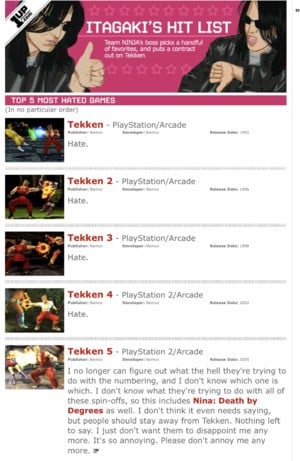
The peak of our growing interview times would be when we hit the 5~6 hour mark after GMR closed, and I moved over to our website 1UP.com. I had pioneered the idea of web ‘cover stories,’ aka feature-length articles that would go up every day over the course of a week, and for this, I needed serious content. So, me, with my trusty tape recorder (I had too many accidents with MiniDisc recorders and digital things losing data, so I stuck to machines I could rely on), meant that interview sessions would last 90 minutes at a time. Tecmo’s poor PR assistant had to run out to the nearby conbini every couple of hours and buy more tapes as we kept discussing every milestone in Itagaki-san’s career for this 1UP cover story “The Art of War.”
From this interview series spawned the viral, pre-meme assembly of Tekken’s Paul Phoenix throwing the same punch, sequel after sequel (hilariously captured by our intern, Jared), captioned by Itagaki with “hate,” “hate,” “hate,” “hate.” He honestly did not care that much about Tekken itself, but started this ‘rivalry’ because of some minor diss by Namco’s marketing team about DOA. Whether his beef was real or it wasn’t (he’s since cleared the air with Tekken’s Harada), it made for good flame wars on the Internet in those days, and if nothing else, it was memorable as hell.
Through the years, and these times were all spread apart far and wide, we got into all sorts of adventures. There was the one time he was in San Francisco, in January 2008, probably for a press tour for Ninja Gaiden II, and one of my colleagues at ZiffDavis was so determined to realize his dream of getting stoned with Itagaki that he brought his most potent bud with him. Itagaki —a buck 25 soaking wet— had never smoked before, and as such was cool for about 15-20 minutes after trying my coworker’s joint, but over the next half hour just disappeared, which sent us into manhunt mode, attempting to find Team Ninja’s leader. We eventually found him passed out in the hotel lobby somewhere, which made me furious with my colleague. “You nearly killed Itagaki!!!” I said hysterically.
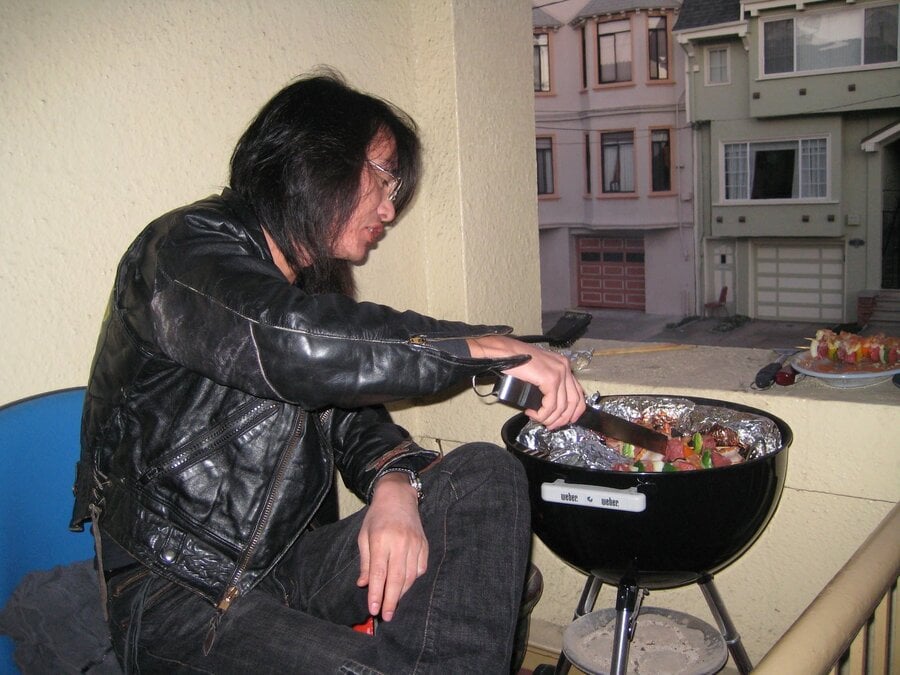
Later, during this same trip, Itagaki-san, along with his longtime producer and right-hand man, Yoshifuru Okamoto, came over to my apartment in San Francisco, where I lived with my fiancée Joy, for a barbecue.
This is where Dead or Alive 4 comes into the picture again. For various reasons, I basically lost my save data when I moved over to a new Xbox, but I wanted to show Joy our names in the credits. So Itagaki-san made Okamoto-san play through the entire game, with every character, so we could see the real ending, and Joy could see both of our names in lights. I felt so bad for Okamoto, and I think he did too, because he was like, “This game is so tough!” and had to beat the game 22 times, and Alpha-152 22 times, for us to see the real ending. It took hours, and there were no shortcuts, no cheats, no debug menus. He had to do it from scratch, while Itagaki just laughed the entire time. These were the best times, with a great friend, sharing quiet moments, drinks, and food at our little apartment out in the Richmond District of San Francisco.
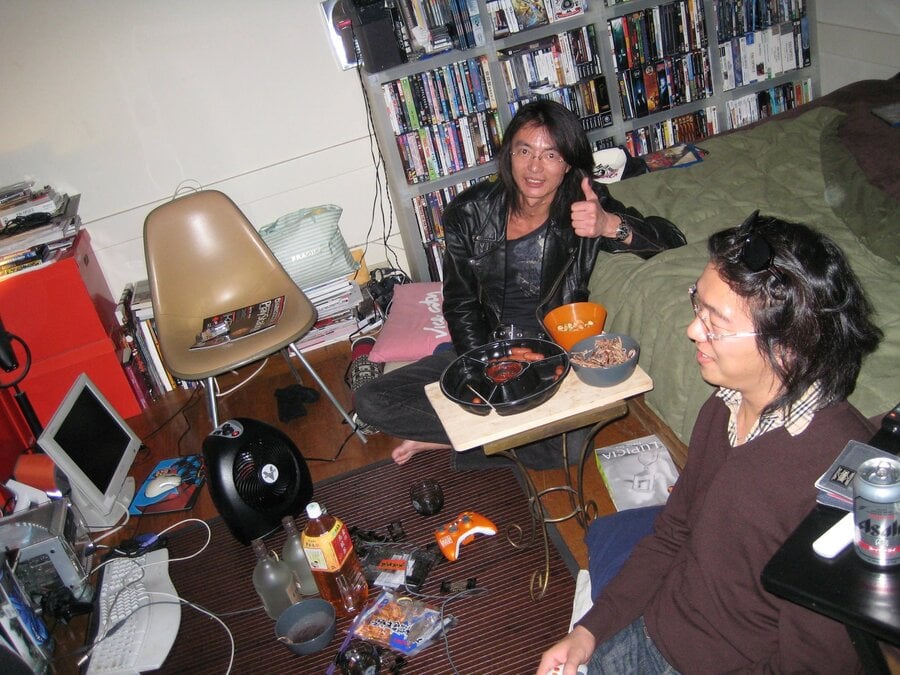
Leaving Home
Around the time Itagaki and many of his core team from Team Ninja were finishing up Ninja Gaiden II, he told me that his time with Tecmo was coming to a close, because they had reneged on various financial obligations (royalties for Dead or Alive 4).
He was planning to leave and start his own development team with Microsoft, which would eventually become Valhalla. He then further surprised me by inviting me to come to Tokyo and work with him on what would become Devil’s Third. This was a real dream come true, something I always hoped to do (move into game development and also live in Tokyo), and to say I was flattered would be an understatement. I was humbled that he thought enough of me to invite me out of the world of games journalism and into the world of game development, and to work directly with him, one of my now-best friends and a real development icon. It was also the hardest thing in the world for me to have to decline.
Around the same time, another gent, by the name of Tetsuya Mizuguchi, coincidentally offered me a similar role as a producer at Q Entertainment, to work on the game Child of Eden. However, because I was expecting my first child around this time, and knew the two very different workstyles of each development team — ex-Team Ninja/Valhalla, smoky offices, sleeping bag under the desk, 24/7/365 crunch time style, and Q Entertainment, normalish hours, smaller more agile games, music games — I knew if I was ever going to see my baby and her mama, I would have to take Mizuguchi-san’s invitation up and gently let Itagaki-san down.
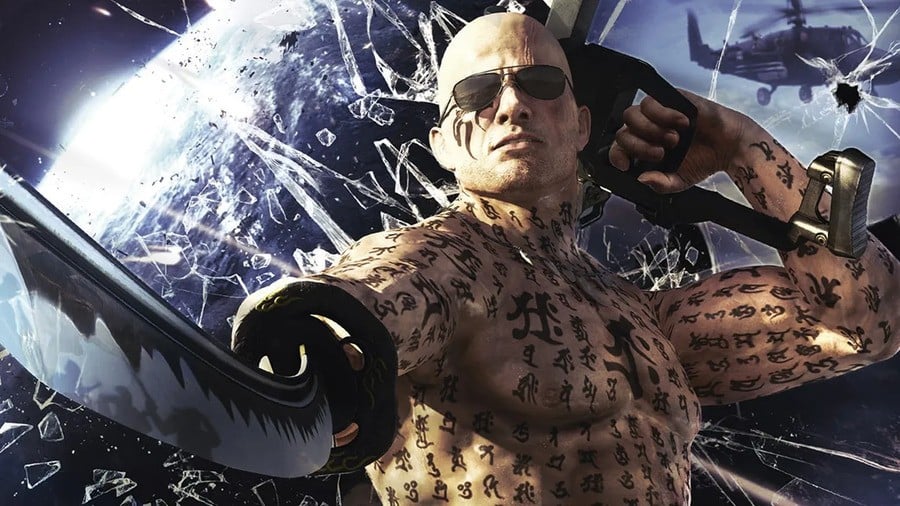
This was not as easy as it sounds on paper. I toiled over this decision for months before finally breaking the news to Itagaki-san. Despite my decision, Itagaki himself said he felt it was the right decision for me, that Q Entertainment was a better fit, and he never held it against me. His friendship revealed itself to me more than ever at that time.
In the end, it did feel like the right decision. While my time at Q Entertainment was shorter than I hoped it would be, because of a change of direction in the company, chasing the new hotness — mobile games — it set off a chain of events that had huge ripple effects for me and the Japanese game industry.
I almost moved to Ubisoft in Paris, but ultimately ended up working for the similarly-named but completely unrelated Q-Games in Kyoto. This was a good transition for me because I was able to discover the beauty of the city, and it’s also where I started BitSummit, which is now the biggest indie festival in the world and the second largest gaming event in Japan. Still, despite these personal successes, I always wondered how different my life would have been if I’d taken Itagaki-san’s offer. By the time I had already worked at both Qs, moved back to NYC, worked for a mobile game company, and then Square Enix’s cloud tech company, Shinra Technologies, Valhalla had only produced one game, Devil’s Third.
The critics weren’t kind to Devil’s Third, and disappointingly, Nintendo shuttered the super-fun multiplayer after only a few months. Ironically, though, this wasn’t ever intended to be a Nintendo game to begin with. It was originally intended to be an Xbox-exclusive title. But as has often happened with Microsoft, leadership changed, and whenever leadership changed, they’d move the tentpoles for whatever the new trends were. In this case, it was Kinect. It sounds laughable now, but at the time, if a game wasn’t designed for Kinect or at least supported Kinect, that was a problem. If a game didn’t have multiplayer built in as a core feature, that was another tentpole gone.
I often wonder what would have happened if I had joined Valhalla instead. Maybe I could have helped shape some of the design decisions, or tempered some of the game's excesses, or just simply been the voice of reason
After the game had finally shipped, I interviewed Itagaki-san about the trials the game had gone through, and he was pretty blunt about it, despite his tendency to answer questions with metaphors about Douglas MacArthur. What started as an Xbox exclusive at one point became multiplatform, before coming full circle and releasing as an exclusive for Nintendo’s Wii U.
I often wonder what would have happened if I had joined Valhalla instead. Maybe I could have helped shape some of the design decisions, or tempered some of the game's excesses, or just simply been the voice of reason, and maybe got the game out on time. I sometimes think about what could have been different if I had decided to join this friend’s team instead of joining my other friend’s team.
Ultimately — although no one realized it at the time — this would be Itagaki-san’s swan song in game development. Internal strife and some executive-level backstabbing led to his departure from the company. I knew he was cooking something up behind the scenes with Itagaki Games/Productions — I don’t know how far along he was in his game’s development or how big his team was or who was on it — but I can only assume we are unlikely to see the results of his final game surface any time soon.
He had recently told me that he’d secured funding for the game, and so I was cautiously optimistic about hearing news about his first new game in over a decade.

For the past decade or so, I made a habit of seeing him whenever I had time during my trips to Japan. On one visit, where he had Joy and I meet him in his hometown in the suburbs of Tokyo, he helped me with the localization and marketing of my company, Tigertron’s game Jupiter & Mars. It was an honor to be able to put him in the credits of one of my games after all those years of finding myself in the Special Thanks sections of his. I don’t recall the name of the area, but it was a beautiful wooded area where we met, and he showed us around the places he used to run around as a kid. The way he describes it, he was already the leader of his group of neighborhood friends, often having to stand up to rival bullies in the area. I can totally see him standing up to some kids twice his size. In fact, it’s exactly the sort of thing he’d do.
But even during this peaceful lunch in the more ‘country’ parts of Tokyo (Tokyo is huge), I could tell my dear friend wasn’t doing so well. He’s always been a hard smoker and a hard drinker, and there’s only so much of that the average human can take. But he consumed above-average amounts of each, and he had a below-average physique. Every time I hugged him goodbye, it was like hugging a leather jacket on a coat hanger; he was so skinny. Despite this, when we’d meet up, he’d always be his usual self, happy to find out what was going on in my life, to share a meal and a drink, and just be content to relax and chat.

I am generally a very busy person. I like to keep myself involved with as many cool projects as I can, and I have a hard time saying no to things —the pandemic was a terrible time for game developers, as it was impossible to get a deal off the ground during those years— so I take nothing for granted. That said, I have been so busy recently that when my wife saw Itagaki-san sharing development war stories from the early days at Tecmo on Facebook, she proposed writing a book about Itagaki-san, because she felt he was wasting this solid gold on Zuckerberg’s platform. While I thought she was out of her mind, due to the size of my work backlog, I’m now extra grateful she encouraged me to informally begin work on this project with Itagaki-san.
We took the idea to Itagaki-san, a concept for a book that would tell his development stories from his perspectives and philosophies, contextualized and editorialized by me, and he was automatically on board and enthusiastic about it. While I didn’t initially relish the idea of all the work involved, I’m now, of course, so glad we did
We took the idea to Itagaki-san, a concept for a book that would tell his development stories from his perspectives and philosophies, contextualized and editorialized by me, and he was automatically on board and enthusiastic about it. While I didn’t initially relish the idea of all the work involved, I’m now, of course, so glad we did. In addition to a wealth of content that he wrote for me to read and then interview him about, I also conducted over four hours of conversation with him, which we recorded on audio and video in support of this book. While we fully intended to do more when the time presented itself, it ended up being the last known conversation he ever had with a games media journalist, and perhaps fittingly, it ended up being with me.
About a year and a half ago, when Joy and I were out to dinner with Itagaki-san in Tokyo, he wasn’t drinking anything. As I rarely drink, it was never a problem. But to see my friend abstain from spirits was unusual. I asked him why he wasn’t having his usual cocktail, and he said Doctor’s orders. His liver had had enough, and he was no longer allowed to drink, at risk to his health. As a result, he went teetotal, which might be difficult for people with lesser mental fortitude, but for Itagaki, it was as simple as saying “I quit.” And so he did. He valued his health more than a drink, and so he cut alcohol out of his life just like that. Thereafter, whenever we would meet up, it was oolong tea for both of us.
But this past month, leading up to my trip to Japan for Tokyo Game Show in September 2025, I reached out to him as I do — I had been meaning to for a while, but was underwater with work — and said I was coming to Tokyo in case he had any free time. His response was “Oh, I’m so glad you sent me a message!” which seemed quite cheerful, but was followed almost immediately with “I’m currently in the hospital and can’t go outside,” and, even more worryingly, “So I can’t go out for a meal. It’s really a shame.” I asked if it was possible to visit him, as there was no way I was going to Tokyo and not making time to see him, and he replied, “Sorry for making you worry. It’s fine for you to visit—just let me know in advance when you’re coming.”
So I made plans to see him after the chaos of TGS was over. Coincidentally, the day before I went to see Itagaki-san, I got news that one of my favorite nieces, who has had stage-4 cancer for years, might not be around much longer, so I made a day trip down to Nara to spend time with her, and then returned to Tokyo the same day.
The next day, after a morning meeting, I made my way to Itagaki-san’s hospital, my heart heavy with the helplessness of the night before and also what I might see when I entered his room.
I checked in at the visitor’s desk on the 1st floor, and where it asks you to put your relationship to the patient, I put “brother.” I took the elevator to the floor he was on, and after I made my way to his room, I could see he wasn’t doing great, although he was seemingly pain-free at that particular moment. My wife Joy had sent flowers on our behalf to his hospital room before my arrival, and they were sitting there by his bedside when I arrived.
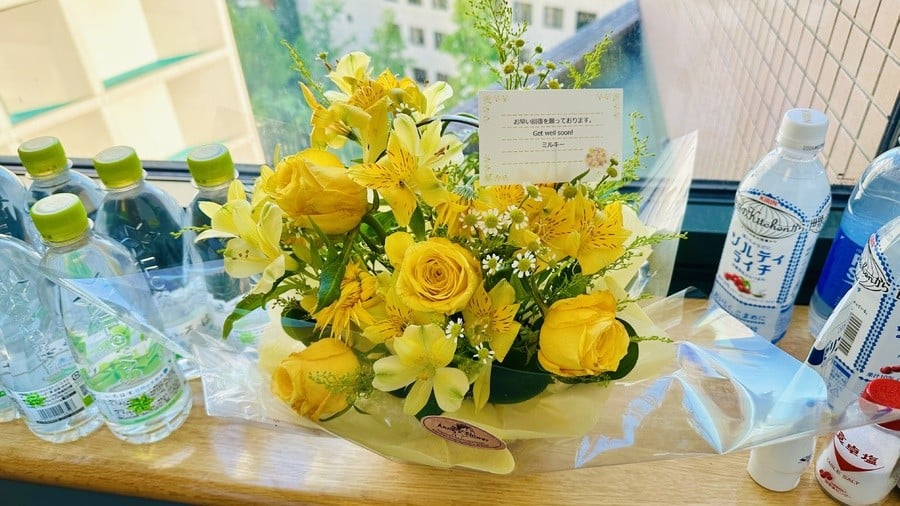
Three months of being bedridden had taken its toll on his body. He was so thin. He spoke about the rehabilitation process ahead of him, and I squeezed his hand in encouragement. We spoke quietly for a while, catching him up on my many projects, and telling him about my kids, who are four years apart but now almost both in their teens.
I asked if he had many visitors. He said that he had not. He’d been in the hospital for three months and didn’t want anyone to really see him in such condition. That Itagaki-san had let me in and let me be there for him said volumes. So I spent that afternoon with my friend. We talked, as friends do. I asked when the doctor would let him go home. He said, “Probably in about a month.” I think we both knew that was wishful thinking, but he seemed ready to get into some rehab, lift some light weights to get his strength back, and make plans for the future. We spent more time talking. I wasn’t in any rush to leave his side. I moved my chair closer to his bedside, as the small chair in the corner had me mostly out of his field of view. So I adjusted it as best I could so he could see me more easily.
We talked, as friends do. I asked when the doctor would let him go home. He said, “Probably in about a month.” I think we both knew that was wishful thinking, but he seemed ready to get into some rehab, lift some light weights to get his strength back, and make plans for the future.
I told him about a secret project I’m working on, and in all seriousness, he said one of the most inspiring things he’s ever said to me, but that’s for another time.
I mentioned to him that I would continue working on the project we did the interviews for. He hasn’t really done any major interviews in the wake of Valhalla’s closure, at least not for a long while. So this will be his first and last major interview, and I want to thank my wife, Joy, once more for pushing me to do this. In this way, I at least get to hear his voice and see him speak about things no one has ever heard him say before.
Eventually, after a couple of hours, I told him that if he was getting tired, he could just let me know, as the last thing I wanted to do was strain his immune system by putting on a good show for me. We talked for a little while more, and after a while, perhaps wanting to let me off the hook —although the last thing I wanted to do at that point was leave— he said, “OK, I’m getting a little tired.” So I gathered my things and put my hand on his arm. We don’t often say these sorts of things because we always assume there will be a next time, but I told him I loved him, because I do. I was worried I’d regret it always if I didn’t say so and if I never saw him again.

He smiled and waved goodbye to me, and I closed the curtains behind me and made my way back down to the lobby and out of the hospital, worried if I’d ever see my brother again.
In the subsequent two and a half weeks, I’ve been back home in New Zealand, and since I last saw him, I messaged him frequently, as did my wife, to check in on him, to let him know he was still in our thoughts, and to keep him company virtually. He wrote back and said, “I’m glad I got to see you too, Milky. I’ll do my best to get discharged soon, so please wait for me.” Later, I sent him a message saying “I hope you’re improving and aren’t feeling too lonely,” to which he replied, “I’m working hard on my rehabilitation!”
The next time I saw his name was when a friend of his who had permission to use his Facebook account messaged me and told me that Itagaki-san had passed away. I was walking on the street in downtown Wellington when I learned that I had lost my brother. Itagaki has always been a force of nature, surviving everything that came his way in the 23 years I’ve known him, but in this instance, his body just wasn’t up to the task.
I want everyone to know that behind the mask of his public persona, behind the bravado and the smack talk and the faux rivalries with other developers, that Tomonobu Itagaki was one of the good guys, easily one of the kindest people I’ve ever known. He wasn’t perfect; he had faults, but he was loyal, and he was always there for his friends.
I want everyone to know that behind the mask of his public persona, behind the bravado and the smack talk and the faux rivalries with other developers, that Tomonobu Itagaki was one of the good guys, easily one of the kindest people I’ve ever known. He wasn’t perfect; he had faults, but he was loyal, and he was always there for his friends. I am lucky to have numbered among them. The Itagaki that the fans know is not the real deal. They don’t know how awesome he was or the compassion he really had for the world around him. They don’t know the spiritual side of things, or the very human things he shared with people like me. He was very gentle, despite the leather jackets and the sunglasses. He did things his way, and the world was better for it. A lot of Japanese developers try to stand out, but Itagaki was one of a kind. I was very fond of him and his laughter. He lived his life to the fullest and always made you feel very much alive to be around him.
He never asked for anything, but he gave so much. I feel strongly that I owe much of my career to Itagaki-san. It was with him that I really discovered my conversational interview style, which helped me with so many other interviews I’ve done. He was the one who, when he met me, told me to introduce myself to everyone as “Milky,” because no one would ever forget that name. He was the one who gave me the nickname “Milkychan” as a sign of endearment. My coverage of his high-profile games helped raise the profile of the publications I worked for, as well as my own profile. It was a real honor to be so close to Team Ninja at their peak, and with Itagaki in particular. He was a natural, born leader, and you could tell by the way his staff respected him.
But he was also quick to acknowledge his own inspirations, like Yu Suzuki, whose AM2 team helped the Dead or Alive team early on to come to grips with Sega’s Model 2 hardware. Itagaki considered Suzuki-san his senpai and always made sure to express reverence whenever his name came up. Game always recognized game.
Game development, especially in Japan, where hours are long and pay is usually low, is hard. I don’t think this is a surprise to anyone. But at Team Ninja, where they worked seven days a week, 18 hours a day, 365 days a year, in offices filled with second-hand smoke, I’ve seen firsthand how much effort goes into making something like Ninja Gaiden Black or Dead or Alive. In no way can people ever really appreciate what it took to produce something like those games in an era before Unreal. Itagaki certainly talked the talk, but also walked it.

His team, in the span of a single decade, released Dead or Alive 3, Dead or Alive Ultimate, Dead or Alive 4, Ninja Gaiden, Ninja Gaiden Black, Ninja Gaiden II, and two Dead or Alive Xtreme Beach Volleyball games in between —all exclusively for Xbox 360— as well as Ninja Gaiden Dragon Sword for Nintendo DS. That’s nine games in 10 years, and not those early arcade games that SNK and Capcom’s teams had to crank out every 6 months (no discredit to them). These were state-of-the-art 3D action games on the most powerful hardware, innovating on every level. Never has there been such a productive period in game development out of Japan in a pre-Unreal era.
Perhaps it was the demands of producing such high-quality games in such a compressed amount of time that took its toll on him, leading him to work so hard and play so hard. Perhaps it was the aftermath of Valhalla’s dissolution that weighed so heavily on him, or maybe it was just that he needed time away to recharge. Most developers would give their left arm to produce one-fifth the amount of discography, let alone the whole works. All I know is that I would rather have had fewer games if it meant more time with the man who called himself my older brother.
That I was able to spend that quiet afternoon by his side is something I will always cherish. I feel no regret because I was able to tell him I loved him, and the conversation we shared that day is etched in my heart. I’ve lost a few very dear friends, people who I call my brothers, from the games industry, and Itagaki-san is undoubtedly the hardest one of all. But he lived his life on his terms, and if anything, this fills me with happiness for him, because he left it all out there, and he gave us so much more of himself than people will ever realize.
Let your soul rest in peace, brother. I will see you on the other side.




